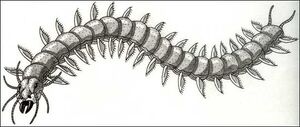| Con Rit | |||
|---|---|---|---|

| |||
| Naming | |||
| Others | Algerian Sea Centipede Cetacean Centipede Great Sea Centipede Many-Finned Sea Serpent | ||
| Binomen | Cetioscolopendra aeliana (Suggested by Bernard Heuvelmans) Mariascolpendra aelani (Suggested by Michael A. Woodley)' | ||
| Morphology | |||
| Body type | Serpentine | ||
| Average length | 50 ft. long | ||
| Intelligence | |||
| Sentience | Sentient | ||
| Sapience | Non-sapient | ||
| Ecology | |||
| Habitat | Southeast Asian Sea | ||
| Diet | Carnivore (presumed) | ||
| Behind the Scenes | |||
| Universe | Real | ||
The Con Rit is a long sea serpent sighted mostly in southeast Asia, especially near the coast of Vietnam. There are also reports from Algeria.
Overview[]
The con rit is very odd, even for a sea serpent. The con rit resembles a gigantic millipede, with jointed, armored segments. Its body is about 50 feet long and a few feet wide. The topside is brown, the underbelly yellow. Each of the many segments is about two feet by three feet, slightly wider than it is long, and each segment contains a pair of small legs about two and a half feet long. In Vietnamese folklore, the con rit is a revered water dragon, identified as the same segmented dragon that appears in the classic folklore book Chich-Quai. It was first sighted off a beach in Hongay, Vietnam where witness claimed it was 18 meters or just over 59 feet long. In 1899, the crew of the HMS Narcissus near Cape Falcon, Algeria saw it and estimated its length at 45 meters or over 147.5 feet
The con rit was most prominent during a 20-year period starting in 1883. There were a number of sightings, and even a carcass (or globster) washed up on the beach and was examined carefully before being dumped at sea to get rid of its unbearable stench. Scientists thought that official recognition for this species might come quickly. But, years passed, sightings became less numerous, and the con rit is still not an official species.
Cryptozoologists have suggested a number of possibilities for what the con rit could be, if it is a real animal. Some say it is a primitive whale that is a relative of the zeuglodons, provided with bony plates. It could also be some sort of giant crustacean or other segmented sea creature, the type of giant "something" that many ordinary scientists expect could be discovered in the deep sea someday. Invertebrates are some of the most frequently discovered animals these days, and if a giant invertebrate were discovered, scientists would expect it to be an oceanic creature, since the ocean is the only place where mainstream scientists think giant undiscovered animals might still lurk. Bernard Heuvelmans suggested it was an armored Basilosaur, however Basilosaurs didn't have armored skin. Michael A. Woodley suggested that it was a fully aquatic descendant of Arthropleura.

